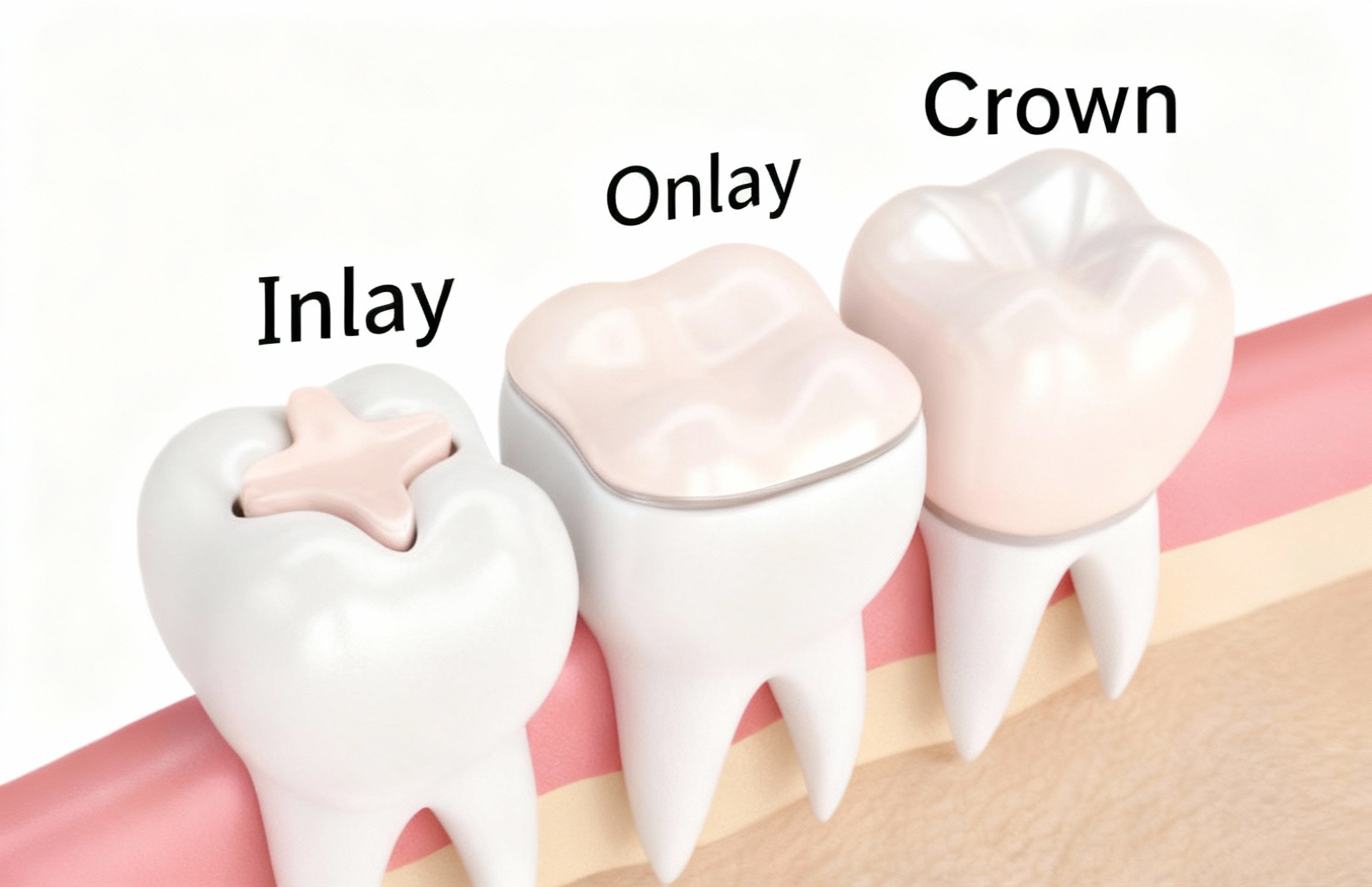Your teeth are meant to last a lifetime; we’re here to help make that happen. Our inlays and onlays provide a conservative yet durable solution for restoring damaged teeth—keeping more of your natural smile intact.

We believe everyone deserves teeth that function properly and look natural. Our inlay and onlay solutions combine advanced dental materials with precise craftsmanship to create durable, conservative restorations. When tooth damage is too extensive for a filling but doesn’t require a full crown, inlays and onlays provide an ideal middle-ground solution that preserves more of your natural tooth structure whilst restoring strength, function, and appearance.
Inlays fit precisely within the cusps of your tooth, whilst onlays extend over one or more cusps to cover larger areas of damage. Both options offer superior durability and aesthetics compared to traditional fillings, helping you maintain a strong, natural-looking smile for years to come.


Inlays and onlays have evolved significantly, combining advanced materials with precise digital craftsmanship to restore damaged teeth effectively. Today’s inlays and onlays offer advantages that make them one of the most conservative options for tooth restoration, delivering both durability and natural-looking aesthetics that surpass traditional filling techniques.
Inlays and onlays require minimal removal of healthy tooth structure compared to crowns, allowing us to conserve more of your natural tooth whilst providing comprehensive restoration for damaged areas.
Made from high-quality materials like porcelain or composite resin, inlays and onlays are designed to withstand normal chewing forces and can last significantly longer than traditional fillings.
Each inlay and onlay is custom-crafted to fit your tooth exactly, ensuring optimal function, comfort, and a seamless integration with your natural tooth structure.
Modern materials can be matched to your natural tooth colour, creating restorations that blend seamlessly with your existing teeth for an undetectable, natural appearance.
By covering and protecting damaged areas, inlays and onlays help strengthen teeth that have been weakened by decay or trauma, reducing the risk of future fractures.
When damage is too extensive for a filling but doesn't warrant a full crown, inlays and onlays provide an ideal middle-ground solution that's less invasive than crown preparation.
Getting inlays and onlays is a straightforward process designed to restore your tooth’s strength, function, and appearance. Below is an overview of the procedure, and our FAQ section provides more detailed information to help you understand each step.










Discover the latest in restorative dentistry, inlays, onlays and dentures. From single-tooth crowns to comprehensive restorations and custom dentures, our articles provide expert guidance, treatment insights, and practical tips to help you restore a strong, natural-looking, and confident smile.

Thinking about getting a dental crown but wondering about the cost? Understanding what affects the price can make it easier to plan. Crowns are made to fix and protect teeth, but their price can change based on different things. Knowing what to expect helps you make a smart choice for your smile. Let’s explore the […]

In dentistry, inlays and onlays are a form of indirect restorations, which means they are made outside of the mouth as a single, solid piece that fits the specific size and shape of the cavity and then cemented in place in the tooth. This process generally takes two visits. Inlays lie inside the cavity of the tooth and do […]

Dental Crowns and Bridges are fixed device that are cemented onto existing teeth or dental implants. It extends the longevity of tooth in patient’s mouth and makes them stronger. Crowns (tooth cap) are commonly used for the following reasons: Cover a damaged tooth and restored a large filling where there is not enough bonding surface […]
Inlays and onlays are custom-made restorations used to repair teeth when damage is too extensive for a filling but doesn’t require a full crown. Inlays fit within the tooth’s cusps, whilst onlays cover one or more cusps, providing durable, conservative restoration that preserves natural tooth structure.
These restorations may be recommended for teeth with moderate to large cavities, cracked or fractured teeth, worn teeth from grinding, or when replacing large, old fillings. They’re ideal when you need more coverage than a filling can provide but less than a full crown.
Inlays are placed within the grooves of your tooth between the cusps, similar to a filling but more durable. Onlays extend over one or more cusps of the tooth, providing broader coverage for more extensively damaged areas.
Unlike fillings that are placed directly into the cavity, inlays and onlays are fabricated in a dental laboratory for precise fit and superior durability. They’re made from stronger materials and typically last longer than traditional fillings.
Common materials include porcelain, composite resin, or gold. Porcelain and composite options can be matched to your natural tooth colour for aesthetic appeal, whilst gold provides exceptional durability though it’s more visible.
With proper care, inlays and onlays can last 10-30 years or longer, depending on the material used, location in the mouth, and individual factors such as oral hygiene and bite forces.
The process typically involves two appointments: the first for tooth preparation and impressions, and the second for placement of the custom-fabricated restoration. A temporary restoration may be placed between appointments.
The procedure is performed under local anaesthetic to ensure comfort. Some mild sensitivity may occur following placement, but this typically subsides within a few days as you adjust to the restoration.
Care for inlays and onlays just like your natural teeth with regular brushing, flossing, and professional cleanings. Avoid chewing on hard objects and consider a nightguard if you grind your teeth.
For appropriate cases, inlays and onlays offer advantages including preserving more natural tooth structure, requiring less tooth preparation, and being more conservative. However, crowns may be necessary for more extensively damaged teeth.
Initial sensitivity to temperature or pressure is normal and should subside within a few weeks. The restoration should feel comfortable and natural once you’ve adjusted to the new restoration.
Depending on the extent of damage, inlays and onlays may sometimes be repaired. However, significant damage typically requires replacement of the entire restoration.
Costs vary depending on the material chosen, size of the restoration, and case complexity. We’ll provide detailed pricing during your consultation and discuss payment options available.
Inlays and onlays are most commonly used on back teeth (premolars and molars) where chewing forces are greatest. The location and extent of damage determine suitability for this type of restoration.